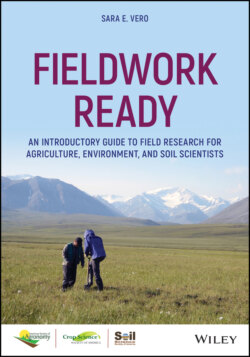Читать книгу Fieldwork Ready - Sara E. Vero - Страница 14
What is “Fieldwork?”
ОглавлениеFieldwork is any research or data gathering conducted outdoors, outside of the laboratory, library, or office settings. As researchers, our individual fields can be almost anywhere (Figs. 1.1 and 1.2). For a sociologist, it might be a school, a shopping mall, or wherever there are people. For a marine biologist, it may be on or even deep within the ocean. This particular guide is generally intended for students and researchers in the broad disciplines of soil, crop, and environmental sciences. However, many of the principles discussed throughout this book will be helpful for any researcher venturing outside of the laboratory setting.
For simplicity, I will refer to all outdoor research as “fieldwork” and all indoor research (be it laboratory, desk, or workshop) as “labwork.”
The challenge faced by researchers in the field is to apply scientific methodologies into environments which are by their very nature, heterogeneous and subject to limited human control. As field researchers, we cannot control the weather, the movements of wildlife, heterogeneity of soils, rock, or vegetation, and innumerable other factors which may influence the results of our investigations. This may seem contrary to the scientific method, which typically controls variables and factors so that one or a few factors of particular interest may be examined independently. In reality, outside of the laboratory, these conditions rarely, if ever, exist (Fig. 1.3). Fieldwork is therefore critical to examine how the theories, devices, and processes developed under controlled conditions perform in reality.
Fig. 1.1 Researchers investigating a soil pit in Ireland.
Source: Sara Vero.
Fig. 1.2 Field research can take you to some breathtaking scenery.
Source: Bo Collins.
Research can be considered to take place within a “hierarchy of complexity” (Read, 2003). Studies that are reductionist in approach, dealing with only one of the many variables which simultaneously influence biological, physical, and chemical functioning in reality, can provide insight into the underlying mechanisms of behavior. However, these effects might be difficult to discern or become less influential at the field scale. These studies offer a high level of “precision,” but perhaps, a lower level of “relevance.” Conversely, field studies allow a broader understanding of patterns and effects within a “real‐world” context. In other words, they have a lower level of “precision,” but a high level of “relevance” (Read, 2003). Of course, there is no strict rule regarding this; rather, it is a spectrum along which various experimental approaches are positioned. For this reason, coupled field and lab studies can be used to develop a more integrated understanding. This is common, especially when developing a thesis at graduate level. Let us take an example. A student investigating potassium (K) requirements of mixed species grassland might conduct three structured experiments.
Fig. 1.3 The field is rarely as tidy and organised as the laboratory.
Source: Bo Collins.
1 A soil incubation study in the laboratory to indicate the release and adsorption potential. This would indicate fundamental chemical behavior of the soil, without any confounding factors.
2 A pot study in a glasshouse or growth chamber to examine the response to various K levels in different species mixtures (Fig. 1.4). This would give an indicator of the potential implications of K availability.
3 A plot study at field scale over three years (Fig. 1.5). This would reveal the impacts of the behaviors observed in detail in the first two experiments, but at an applied spatial and temporal scale. Results from this approach can be used to develop recommendations for farm management.
While the conclusions from experiment one could be extrapolated to the field scale, without the bridging provided by experiment two, and the real‐world implications observed in the field during experiment three, any recommendations derived thus would be vulnerable to overemphasis or misinterpretation. Conversely, while field experiments might reveal the implications or applications of (for example) farm management practices, they may struggle to differentiate the underlying causative factors. A joint approach incorporating both laboratory and field elements can often yield a more comprehensive understanding, and justified conclusions than either can in isolation.
Fig. 1.4 A pot study in a glasshouse can be highly controlled.
Source: Bo Collins.
Fig. 1.5 A plot study like this grass trial can be used to examine effects of fertilizer, drought, crop species etc. under ‘real world’ conditions, and can be integrated with laboratory approaches such as pot trials or incubations.
Source: Sara Vero.
